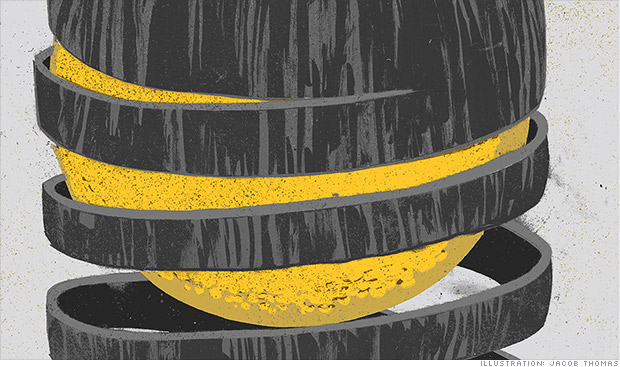
The old divide between growth and value investing is fading. Ask the fund managers who own Apple.
(Money Magazine)
The question may seem like a no-brainer. Financial stocks are synonymous with value investing, which prizes low price-to-earnings multiples, high dividends, and modest, dependable profit growth. Tech has long been the hunting ground for growth investors willing to pay up for a company that's rapidly increasing earnings.
Today, however, Apple (AAPL, Fortune 500) shares are 15% cheaper than Bank of America's (BAC, Fortune 500), based on forecast profits, while they yield nearly seven times as much. And BAC's earnings, post-financial crisis, are set to grow 24% a year for the next two years -- more than twice as fast as Apple's.
Warren Buffett argued two decades ago that Wall Street's bipolar worldview of growth and value exemplified "fuzzy thinking." Those lines are even fuzzier now.
Related: 5 reasons this bull market can still run
George Sertl, a portfolio manager at Artisan Partners, says that until the mid-2000s, Artisan's value-oriented managers paid little mind to tech stocks, which were expensive and offered no dividends.
Today tech sports the third-lowest P/E in the S&P 500 and is the largest contributor of dividends. More than a quarter of Artisan Value's (ARTLX) portfolio is currently in tech, and the fund, like 20% of its value peers, now owns Apple, whose stock price has declined by a third of late. Meanwhile, about one in seven growth-stock funds holds BAC.
So what does this mean for building a sound portfolio?
Forget labels. When looking at a mutual fund or ETF that has "value" or "growth" in its name, don't assume you know what kinds of stocks it holds. Check top holdings on Morningstar.com.
Don't use growth and value to market time. Historically, a rally in value like we've seen of late means that investors are growing risk averse -- bad for stocks in general. When growth outperforms, investors are thought to be confident. Yet Sam Stovall, chief equity strategist for S&P Capital IQ, found that since 1999, growth and value performance have been terrible predictors of overall returns.
Think in fours, not twos. Sudhir Nanda, head of quantitative equity research at T. Rowe Price, looks at the market in quadrants: cheap and fast growing; expensive and fast growing; cheap and slow growing; and expensive and slow growing.
Related: Portfolio - a better way to stay on top of your investments
"Growth and value aren't necessarily mutually exclusive," he says. Looking in that first quadrant -- often called "growth at a reasonable price," or GARP -- can pay off. Since 2000, the S&P growth-stock index has been flat, while the IQ GARP index has returned nearly 10% annually. Jensen Quality Growth (JENSX), a member of the MONEY 70, is a GARP fund that has tripled the market's return since 2000. ![]()
First Published: April 4, 2013: 6:23 AM ET
Anda sedang membaca artikel tentang
Why growth and value investing aren't so different anymore
Dengan url
http://bolagaya.blogspot.com/2013/04/why-growth-and-value-investing-arent-so.html
Anda boleh menyebar luaskannya atau mengcopy paste-nya
Why growth and value investing aren't so different anymore
namun jangan lupa untuk meletakkan link
Why growth and value investing aren't so different anymore
sebagai sumbernya
0 komentar:
Posting Komentar